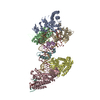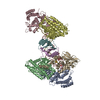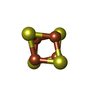[English] 日本語
 Yorodumi
Yorodumi- PDB-8d3m: Type I-C Cas4-Cas1-Cas2 complex bound to a PAM/Processed prespacer -
+ Open data
Open data
- Basic information
Basic information
| Entry | Database: PDB / ID: 8d3m | |||||||||||||||||||||||||||||||||||||||||||||
|---|---|---|---|---|---|---|---|---|---|---|---|---|---|---|---|---|---|---|---|---|---|---|---|---|---|---|---|---|---|---|---|---|---|---|---|---|---|---|---|---|---|---|---|---|---|---|
| Title | Type I-C Cas4-Cas1-Cas2 complex bound to a PAM/Processed prespacer | |||||||||||||||||||||||||||||||||||||||||||||
 Components Components |
| |||||||||||||||||||||||||||||||||||||||||||||
 Keywords Keywords | HYDROLASE/DNA / CRISPR Cas adaptation type I-C / HYDROLASE-DNA complex | |||||||||||||||||||||||||||||||||||||||||||||
| Function / homology |  Function and homology information Function and homology information5' to 3' exodeoxyribonuclease (nucleoside 3'-phosphate-forming) / exonuclease activity / maintenance of CRISPR repeat elements / iron-sulfur cluster binding / RNA endonuclease activity / DNA endonuclease activity / defense response to virus / Hydrolases; Acting on ester bonds / magnesium ion binding / protein homodimerization activity ...5' to 3' exodeoxyribonuclease (nucleoside 3'-phosphate-forming) / exonuclease activity / maintenance of CRISPR repeat elements / iron-sulfur cluster binding / RNA endonuclease activity / DNA endonuclease activity / defense response to virus / Hydrolases; Acting on ester bonds / magnesium ion binding / protein homodimerization activity / DNA binding / metal ion binding Similarity search - Function | |||||||||||||||||||||||||||||||||||||||||||||
| Biological species |  Alkalihalobacillus halodurans C-125 (bacteria) Alkalihalobacillus halodurans C-125 (bacteria)synthetic construct (others) | |||||||||||||||||||||||||||||||||||||||||||||
| Method | ELECTRON MICROSCOPY / single particle reconstruction / cryo EM / Resolution: 3.41 Å | |||||||||||||||||||||||||||||||||||||||||||||
 Authors Authors | Dhingra, Y. / Suresh, S.K. / Juneja, P. / Sashital, D.G. | |||||||||||||||||||||||||||||||||||||||||||||
| Funding support |  United States, 2items United States, 2items
| |||||||||||||||||||||||||||||||||||||||||||||
 Citation Citation |  Journal: Mol Cell / Year: 2022 Journal: Mol Cell / Year: 2022Title: PAM binding ensures orientational integration during Cas4-Cas1-Cas2-mediated CRISPR adaptation. Authors: Yukti Dhingra / Shravanti K Suresh / Puneet Juneja / Dipali G Sashital /  Abstract: Adaptation in CRISPR-Cas systems immunizes bacteria and archaea against mobile genetic elements. In many DNA-targeting systems, the Cas4-Cas1-Cas2 complex is required for selection and processing of ...Adaptation in CRISPR-Cas systems immunizes bacteria and archaea against mobile genetic elements. In many DNA-targeting systems, the Cas4-Cas1-Cas2 complex is required for selection and processing of DNA segments containing PAM sequences prior to integration of these "prespacer" substrates as spacers in the CRISPR array. We determined cryo-EM structures of the Cas4-Cas1-Cas2 adaptation complex from the type I-C system that encodes standalone Cas1 and Cas4 proteins. The structures reveal how Cas4 specifically reads out bases within the PAM sequence and how interactions with both Cas1 and Cas2 activate Cas4 endonuclease activity. The Cas4-PAM interaction ensures tight binding between the adaptation complex and the prespacer, significantly enhancing integration of the non-PAM end into the CRISPR array and ensuring correct spacer orientation. Corroborated with our biochemical results, Cas4-Cas1-Cas2 structures with substrates representing various stages of CRISPR adaptation reveal a temporally resolved mechanism for maturation and integration of functional spacers into the CRISPR array. | |||||||||||||||||||||||||||||||||||||||||||||
| History |
|
- Structure visualization
Structure visualization
| Structure viewer | Molecule:  Molmil Molmil Jmol/JSmol Jmol/JSmol |
|---|
- Downloads & links
Downloads & links
- Download
Download
| PDBx/mmCIF format |  8d3m.cif.gz 8d3m.cif.gz | 347.1 KB | Display |  PDBx/mmCIF format PDBx/mmCIF format |
|---|---|---|---|---|
| PDB format |  pdb8d3m.ent.gz pdb8d3m.ent.gz | 280.5 KB | Display |  PDB format PDB format |
| PDBx/mmJSON format |  8d3m.json.gz 8d3m.json.gz | Tree view |  PDBx/mmJSON format PDBx/mmJSON format | |
| Others |  Other downloads Other downloads |
-Validation report
| Summary document |  8d3m_validation.pdf.gz 8d3m_validation.pdf.gz | 1.7 MB | Display |  wwPDB validaton report wwPDB validaton report |
|---|---|---|---|---|
| Full document |  8d3m_full_validation.pdf.gz 8d3m_full_validation.pdf.gz | 1.7 MB | Display | |
| Data in XML |  8d3m_validation.xml.gz 8d3m_validation.xml.gz | 63 KB | Display | |
| Data in CIF |  8d3m_validation.cif.gz 8d3m_validation.cif.gz | 92 KB | Display | |
| Arichive directory |  https://data.pdbj.org/pub/pdb/validation_reports/d3/8d3m https://data.pdbj.org/pub/pdb/validation_reports/d3/8d3m ftp://data.pdbj.org/pub/pdb/validation_reports/d3/8d3m ftp://data.pdbj.org/pub/pdb/validation_reports/d3/8d3m | HTTPS FTP |
-Related structure data
| Related structure data |  27160MC  8d3lC  8d3pC  8d3qC M: map data used to model this data C: citing same article ( |
|---|---|
| Similar structure data | Similarity search - Function & homology  F&H Search F&H Search |
- Links
Links
- Assembly
Assembly
| Deposited unit | 
|
|---|---|
| 1 |
|
- Components
Components
-CRISPR-associated endonuclease ... , 2 types, 6 molecules ABCDEF
| #1: Protein | Mass: 39393.340 Da / Num. of mol.: 4 Source method: isolated from a genetically manipulated source Source: (gene. exp.)  Alkalihalobacillus halodurans C-125 (bacteria) Alkalihalobacillus halodurans C-125 (bacteria)Strain: ATCC BAA-125 / DSM 18197 / FERM 7344 / JCM 9153 / C-125 Gene: cas1, BH0341 / Production host:  References: UniProt: Q9KFX9, Hydrolases; Acting on ester bonds #2: Protein | Mass: 11038.668 Da / Num. of mol.: 2 Source method: isolated from a genetically manipulated source Source: (gene. exp.)  Alkalihalobacillus halodurans C-125 (bacteria) Alkalihalobacillus halodurans C-125 (bacteria)Strain: ATCC BAA-125 / DSM 18197 / FERM 7344 / JCM 9153 / C-125 Gene: cas2, BH0342 / Production host:  References: UniProt: Q9KFX8, Hydrolases; Acting on ester bonds |
|---|
-DNA chain , 2 types, 2 molecules GH
| #3: DNA chain | Mass: 10139.498 Da / Num. of mol.: 1 / Source method: obtained synthetically / Source: (synth.) synthetic construct (others) |
|---|---|
| #4: DNA chain | Mass: 9840.351 Da / Num. of mol.: 1 / Source method: obtained synthetically / Source: (synth.) synthetic construct (others) |
-Protein , 1 types, 1 molecules I
| #5: Protein | Mass: 25403.396 Da / Num. of mol.: 1 Source method: isolated from a genetically manipulated source Source: (gene. exp.)  Alkalihalobacillus halodurans C-125 (bacteria) Alkalihalobacillus halodurans C-125 (bacteria)Gene: cas4, E2L07_14035 / Production host:  References: UniProt: A0A4Y7WTW2, 5' to 3' exodeoxyribonuclease (nucleoside 3'-phosphate-forming) |
|---|
-Non-polymers , 2 types, 2 molecules 


| #6: Chemical | ChemComp-MN / |
|---|---|
| #7: Chemical | ChemComp-SF4 / |
-Details
| Has ligand of interest | Y |
|---|---|
| Has protein modification | N |
-Experimental details
-Experiment
| Experiment | Method: ELECTRON MICROSCOPY |
|---|---|
| EM experiment | Aggregation state: PARTICLE / 3D reconstruction method: single particle reconstruction |
- Sample preparation
Sample preparation
| Component | Name: Type I-C Cas4-Cas1-Cas2 complex with a PAM/Processed substrate Type: COMPLEX / Entity ID: #1-#5 / Source: MULTIPLE SOURCES |
|---|---|
| Molecular weight | Experimental value: NO |
| Source (natural) | Organism:  Alkalihalobacillus halodurans C-125 (bacteria) Alkalihalobacillus halodurans C-125 (bacteria) |
| Source (recombinant) | Organism:  |
| Buffer solution | pH: 7.5 Details: 20 mM HEPES (pH 7.5), 100 mM KCl, 5% glycerol, 2 mM DTT, and 2 mM MnCl2 |
| Specimen | Conc.: 0.75 mg/ml / Embedding applied: NO / Shadowing applied: NO / Staining applied: NO / Vitrification applied: YES |
| Specimen support | Grid material: COPPER / Grid type: Quantifoil R1.2/1.3 |
| Vitrification | Instrument: FEI VITROBOT MARK IV / Cryogen name: ETHANE / Humidity: 100 % |
- Electron microscopy imaging
Electron microscopy imaging
| Microscopy | Model: TFS GLACIOS |
|---|---|
| Electron gun | Electron source:  FIELD EMISSION GUN / Accelerating voltage: 200 kV / Illumination mode: OTHER FIELD EMISSION GUN / Accelerating voltage: 200 kV / Illumination mode: OTHER |
| Electron lens | Mode: BRIGHT FIELD / Nominal defocus max: 3500 nm / Nominal defocus min: 1500 nm |
| Specimen holder | Cryogen: NITROGEN |
| Image recording | Electron dose: 50 e/Å2 / Film or detector model: GATAN K3 (6k x 4k) |
- Processing
Processing
| Software | Name: PHENIX / Version: 1.19.2_4158: / Classification: refinement | ||||||||||||||||||||||||
|---|---|---|---|---|---|---|---|---|---|---|---|---|---|---|---|---|---|---|---|---|---|---|---|---|---|
| EM software | Name: PHENIX / Category: model refinement | ||||||||||||||||||||||||
| CTF correction | Type: NONE | ||||||||||||||||||||||||
| 3D reconstruction | Resolution: 3.41 Å / Resolution method: FSC 0.143 CUT-OFF / Num. of particles: 228000 / Symmetry type: POINT | ||||||||||||||||||||||||
| Refine LS restraints |
|
 Movie
Movie Controller
Controller






 PDBj
PDBj








































